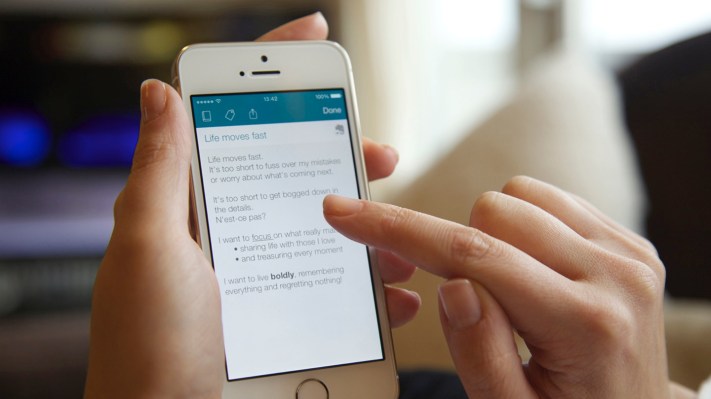SwiftKey, the word-predicting artificially intelligent keyboard made by a U.K. startup — whose machine-learning software was on more than 100 million devices globally last year (most of them Androids) — is finally addressing the mainstream iPhone/iPad user.
Not, sad to say, as an alternative iOS keyboard that can be used natively across the phone. That remains an impossible dream because Apple still doesn’t allow third parties to create alternative system global keyboards. Instead, SwiftKey has done the next best thing it can at this point: launched a note-taking app, called SwiftKey Note, to let iOS users get a taste of what its word-predicting engine can do.
The launch of SwiftKey Note was rumoured last week, after @evleaks tweeted some images of the app. Those earlier leaks have been confirmed today with SwiftKey Note landing on the App Store as a free download for iOS — compatible with iOS 6 and above, and currently including language support for English (US), English (UK), French (FR), French (CA), German, Italian, Spanish (ES), Spanish (US)).
The app gives iOS users the ability to use SwiftKey’s word-prediction technology within a single app interface on the platform, and thus speed up a portion of their typing on iPhones and iPads. The company has previously shown off a build of its software designed for iPad-owning medical students but this is the first iOS app it’s released that targets a mainstream user.
“This is our first consumer app on iOS, first app on iOS at all,” says SwiftKey co-founder Ben Medlock during a briefing with TechCrunch. “There’s a number of things we wanted to achieve through this launch — one of those, primarily, was to give people a taste of the text prediction technology.”
The application of these [AI] techniques is just at the beginning… This is really what’s going to change the face of mobile over the next five to ten years.
The app is also, evidently, a way for SwiftKey — a mobile startup that cut its teeth on Google’s Android platform — to take its first baby steps into Apple’s iOS ecosystem. Which is the reverse of how a lot of app development still goes down.
“For such a long time people have been saying ‘I wish I could use SwiftKey on my iPhone/iPad’, and we’ve wanted to be cross-platform for a very long time. And everything we’re doing with SwiftKey Cloud is all about giving users a consistent experience, whatever device they’re on, whatever platform they’re on. That’s really important to us.
“But we also recognise that this is a new platform and there’s a lot that we have to learn about engaging with the iOS community as well as the Android community,” says Medlock.
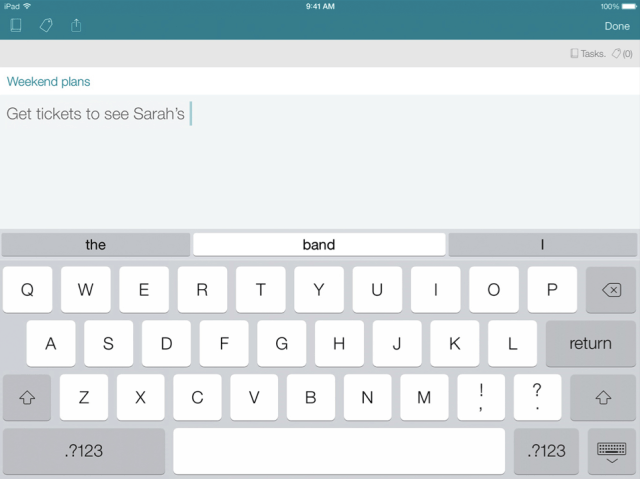
Who is the SwiftKey Note app aimed at? Journalists are one target, says Medlock, owing to a tendency to work on the fly and use lots of different mobile devices types and platforms; students who need a note-taking tool that can quickly pick up specialist terminology and nomenclature are another; and, generally, it’s for people who care about productivity.
“The product has a productivity focus to it. It’s really focused on people who want to get stuff done — it’s clean, it’s elegant, it’s built around efficiency,” adds Medlock.
The arrival of SwiftKey on iOS does not mean the company believes its growth on Android is tapped out. Rather, Medlock says, moving onto Apple’s platform is about growing its long-stated cross-platform ambitions — and also expanding its user-base so it can push into new app categories in future. “There’s plenty of scope for growth on Android, but that’s complementary to growing across other platforms as well,” he says.
With platform expansion in mind, the Note app is also clearly a showcase for iOS developers who might be thinking about integrating SwiftKey’s core prediction engine into their own apps.
Also noteworthy: SwiftKey took in a $17.5 million Series B funding round last autumn, later expanding its roster by confirming Accel as an additional investor, so there’s likely fresh VC impetus to see the company grow in new ways — and pushing into the second largest mobile ecosystem by global marketshare is an obviously untapped opportunity for SwiftKey (albeit untapped because the obvious route onto the platform has been barred by Apple’s rules).
“The nice thing about being in a growing company is that increasingly there are components that you’ve already built that you can plug in. And now that we’ve done this we’re starting to build out that portfolio of pieces on iOS as well,” says Medlock. “We already had the toolkit [SDK] which was in some ways as big a piece of work as the [Note] app itself.
“So what you see in this app is the kind of thing that if we were to work with partners to bring the same technology to other apps, this is pretty much what it would look like.”
“This SwiftKey Note app very much builds on our core typing proposition but… our aspirations are around taking this technology and deploying it more widely,” he adds. “So when we think about the future for SwiftKey we think about it in terms of… other applications that are built on the same AI/machine-learning technology, and again the more we learn about building distinct apps on different platforms, the more we’re able to in future expand that.”
The elephant in the room
The SwiftKey Note app has an option to integrate with Evernote — so another key point here is that SwiftKey is not trying to compete with the elephant in the note-taking room. It’s going down the partnership route.
The Evernote account sign-in option allows for documents to be written up speedily in Note, using SwiftKey’s word-prediction engine, then synced and saved back to Evernote’s platform for back-up and the ability to access them on other devices via that platform’s reach (initially Note does not integrate with SwiftKey’s own Cloud — making the Evernote outreach all the more important).
Evernote users who choose to connect SwiftKey’s app with their Evernote account derive additional benefit by allowing SwiftKey to parse their Evernote document archive which allows the AI engine to short-cut the getting-to-know-your-writing style proces (i.e. instead of needing to be nurtured through a learning curve by typing in a representative sample of documents to tailor its word-prediction powers to your writing).
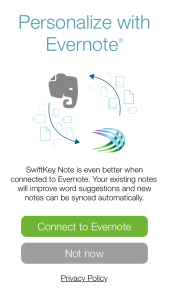 At this point, with SwiftKey being the new kid on the iOS block, adding a line in to Evernote looks like a way for it to piggyback on the popularity of an established big-name iOS app as it takes its first steps onto a shiny new platform. So it’s also part of SwiftKet’s strategy to short-cut its way to popularity in a whole new mobile ecosystem.
At this point, with SwiftKey being the new kid on the iOS block, adding a line in to Evernote looks like a way for it to piggyback on the popularity of an established big-name iOS app as it takes its first steps onto a shiny new platform. So it’s also part of SwiftKet’s strategy to short-cut its way to popularity in a whole new mobile ecosystem.
For those iOS users who haven’t used SwiftKey and don’t use Evernote the app’s word-prediction powers will improve the most as you type in up to 100 documents in your personal writing style. After that it will continue getting to know your slang, syntax and so on, and getting better, but that early portion of data entry will see the biggest leaps in its predictive powers, according to Medlock.
This algorithmic learning curve does mean newcomers to SwiftKey will need to be a bit patient before they see the real benefits. And that learning period is a barrier to SwiftKey’s Note app taking off with virgin users — especially as iOS users have been conditioned (through lack of keyboard choice) to hen-peck out individual letters on Apple’s iOS keyboard and lean on autocorrect for a little typo help (or hilarity).
Treading softly
Unsurprisingly, then, SwiftKey’s interface in the Notes app keeps the look and feel of the iOS keyboard — to maintain continuity with what iPhone and iPad users are used to. The main difference is a bar above the keyboard where the three next-word suggestions are displayed as the user types, allowing them to tap on one of the full word predictions displayed, rather than carry on tapping out the rest of the individual letters. There’s also a swipe left option on this bar to short-cut to a few formatting options, such as bold, bullet points and text alignment.
Visually the app’s keyboard interface does all it can to blend in, at this point — “it’s minimally invasive”, is how Medlock puts it — which may result in some less patient iOS users wondering what the big advantage is. (The Notes app has a few other features — such as the ability to group notes into Notebooks, and to tag individual notes for easier retrieval via keyword search but the big showcase here is SwiftKey’s word-prediction engine.)
Whether iOS users can be convinced to convert to a new way of typing — especially one that’s only available in one app at present — will be interesting to watch via SwiftKey Note uptake.
SwiftKey’s initial Android growth started slow, according to Medlock, with usage growing via word of mouth over a year or two as converts told their friends who in turn became users, rather than via any big-bang marketing efforts. Now, some four years after an alpha launch on Android, the startup is starting again from scratch on the iOS platform with Note.
Except the app it’s launching is a fully formed product, rather than an alpha build; and it’s launching it as an established brand with multi-millions of fans, not a scrappy startup with a handful of employees. So this launch isn’t by any means stone cold. So SwiftKey should certainly expect some bump from cross-pollinating device users downloading something they know and love immediately, even if it’s hard to predict how much of a bump they’ll get.
Even so, Medlock says it’s not taking anything for granted as it enters the iOS camp. “There’s a lot of learning for us in this, and what we know is that a lot of people have written to us and said we’d love to see this technology on iOS, but beyond that we don’t know what proportion of users that represents… We expect to learn a lot after the launch but we’re holding everything open at the moment.” 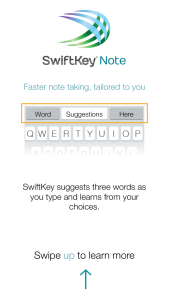
It has also spent a lot of time on “on-boarding” with this app, including building a tutorial to get iOS newbies up to speed on the basic premise of SwiftKey — and to sell the concept of a new type of typing to them.
“We recognise that this isn’t going to suit everybody straight away but we hope that the on-boarding tutorial gives people enough of a grounding in the way it works that they’ll be able to try it out and even if they don’t instantly like it, maybe they come back to it, maybe they start to get used to over time,” Medlock adds.
This new slick SwiftKey experience, with well thought through on-boarding, is the look and feel it will be adopting for all new launches going forward, according to Medlock. So under the hood go the keyboard nerds and stats geeks — and out comes an elegant it-just-works swipe-up-to-learn-more interface, and a short sequence of animated graphical product walk-throughs to hand-hold the user through the app adoption process. Welcome to iOS.
iOS After Android
But why is SwiftKey doing an iOS app now, at this point in time — not last year, say, or even earlier? It has actually mocked up apps for the platform several times before, according to Medlock, but after its success on Android he says the company wanted to be sure it could launch on iOS with a bang not a whimper.
“It’s actually something that we’ve part built about three times before this, so for me I’ve always been looking for something that I felt was a compelling enough entry point because building a mediocre product, particularly after we had such great traction on Android, would just have been so disappointing to have something that wasn’t great. And so the products that we’ve prototyped, to me were just never quite up to the standard,” he says.
“Actually it was the Evernote link, and being able to build something that had a really clear target — that was what provided the impetus to take this all the way to launch. It’s not the first time we’ve thought or worked on this stuff, but it’s the first time we’ve got something that we’re proud enough of to go public with.”
In addition, Medlock says SwiftKey wanted to put an app out there now that can act as a showcase to other developers of what its technology would look like integrated into their own iOS apps.
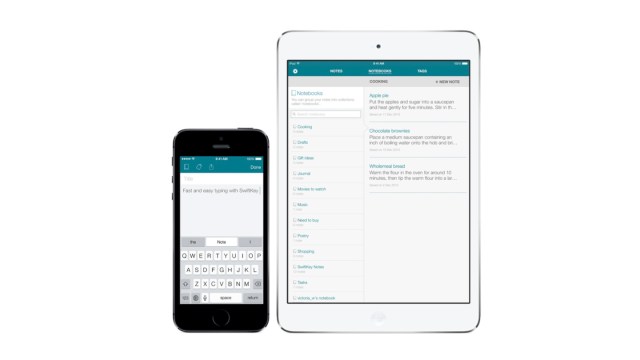
“One of the reasons here is that we’ve had the toolkit for a little while and we wanted to have a reference integration, not just a demo but a real product — where we could show people this is what it looks like to integrate this technology into an iOS app. So now when we’re exploring the possibility of integrating with third parties it’s just so much easier to say ‘look, this is an example of how it works and what it looks like’,” he adds.
“That’s a really exciting possibility for us. We don’t have anything concrete to talk about around that but our vision… is to explore all possibilities for distributing this tech as widely as we can.”
Medlock doesn’t mention Apple but it may well be that SwiftKey was still, up until recently, holding out hope that Apple might open up the iOS keyboard to outside developers — giving it the core route onto the platform that it must surely still crave. He does say that development work on the Note app took “the majority of last year”. Which gives some sense of the scope of SwiftKey’s investment here, with an iOS app that’s free for users to download.
SwiftKey’s Android app is of course a paid download (costing $3.99) but being as the iOS app is (necessarily) a lighter offering, since the word-prediction keyboard only functions within a single app, SwiftKey has gone down the free-to-download route.
The app, which was developed by a mix of existing SwiftKey devs who had worked on the Android product and new hires with iOS development experience, also does not include its drag-to-type Flow interface at this point — although that may be added in future.
Initially, reiterates Medlock, the idea was to keep the experience similar to the tap-to-type modus operandi that all iOS users are used to — so that was one reason not to muddy the waters by adding Flow at this early point (i.e. before the Note app has established a user-base).
Incorporating Flow would also have been more challenging from a development point of view, says Medlock.
“Partly it’s about how much you have to re-engineer the iOS experience… In order to do Flow you have to control that bit of the screen that actually contains the Apple keyboard so it’s a more difficult challenge,” he says, adding: “It’s something we’ve prototyped, and it’s something that may well come in future.
“That’s on the ‘major potential future feature-list’ — and part of what we want to do is gauge feedback to understand how important these different things are to people.”

An Artificially Intelligent Future
Despite the Note app being something of a learning exercise for SwiftKey — both about the technical challenges of building iOS apps and the softer but more subtle challenge of understanding iOS users — the U.K. startup that’s grown to employee more than 130 people and have offices in London, San Francisco and Seoul, does have big ambitions for growing its reach on Apple’s platform. And, as mentioned above, for expanding the reach of its software and AI engine generally (related for instance: it recently did a tie-up with Clarion to take its keyboard into a car stereo interface).
So now that SwiftKey’s first consumer iOS app is here, expect more iOS apps from the company — and more iOS developers to incorporate its prediction engine in their wares. Ultimately, if SwiftKey’s pitch to other developers via this showcase app pays off, its core tech could end up parachuting in to the iOS platform to invade the platform via a plethora of flagship entry-point apps — even if an official set of keys to Apple’s kingdom continues to be withheld.
“I wouldn’t exactly say [releasing SwiftKey Note is] resignation [that Apple won’t ever let us in],” says Medlock when I ask about the Apple point. “But it’s a sense of we want to be moving forwards and we just don’t know whether Apple is going to do something with the keyboard framework or not, so let’s look at an alternative route.”
To date SwiftKey has made a business off of licensing its keyboard software to OEMs who preload it as an option. It has also sold direct to mobile users on platforms such as Android. But its ambitions clearly stretch a lot wider and broader than the 100 million+ devices it was embedded on last year.
Medlock won’t be drawn into specifics on the sort of areas where SwiftKey is looking to apply its technology in future, but there’s no doubt it is thinking outside the letter-stamped-box for future launches and licensing opportunities.
“There’s nothing quite like building new things, and we’re doing quite a lot of work around exploring new avenues,” he tells TechCrunch. “That’s for the future, in terms of anything concrete, but it’s a glimpse of where we want to be heading.
“It’s about modelling people’s behaviour in different contexts and then building software that helps them to do what they want to do, because it understands the way they behave, whether that’s through text or through other things they do on their mobile device, and whilst we can’t talk in concrete terms about the areas that we’re exploring, we are exploring different things. And there’s so many ideas that we have around new directions.”
Medlock adds: “Our investors are excited about the business because of the cross-platform story, because this is something that we want to see distributed as widely as possible, that breaks down those barriers between different apps, between different platforms and between different devices.”
The ultimate vision here, for SwiftKey, is far grander than the sum of a few keyboard-shaped parts. It’s eyeing up how the machine-learning algorithms it builds can steer, shape and define the future of mobile technology in increasingly savvy ways.
“Ultimately, what we care about is using smart technology to make people’s mobile lives easier — and we believe that the application of the kind of new generation technologies that we are building up our expertise in will change the way people interact with all of their core applications across all of their mobile devices, and we want to be one of the leaders in that space,” says Medlock.
“The reason we think this business, this opportunity is so exciting is because the application software layer is changing so fast at the moment — hardware has kind of homogenised, so every phone pretty much looks the same — but the software, the application of these kind of [AI] techniques is just at the beginning… This is really what’s going to change the face of mobile over the next five to ten years.
“And in five years’ time I want SwiftKey not only to have users on a scale that is far beyond what we have today but also to be recognised as a leader in bringing this next generation artificial intelligence technology to the masses.”
